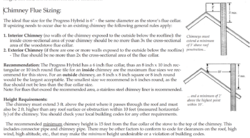Good afternoon Guys,
I have a Progress Hybrid that I purchased at the end of this last season. I am doing rear discharge, hooked to a 35' brick internal chimney with a 10" x 10" flue. Chimney goes though the roof at the peak of my home and does not have other trees or objects with in 50 feet of the outlet. I have a clean out in the bottom of the chimney that is of course below where the stove pipe goes into the flue. I also have a clean out in the attack about 10 feet from the top of the chimney. Both clean outs are gasketed and tight. Chimney flue is clean. House stove is installed in is 3000 sq.f with no insulation but new windows. Makeup air is not an issue to say the least. I am having puff backs with the stove. Not horrible like a coal stove can give you but bad enough where the smoke gets shot out of the back of the stove. Sometimes it happens right after loading and some times it is hours later. Wood being used is a mix of southern yellow pine 2x4 cutoffs that are 10% or less moisture and red oak that is 25% - 30% internal moisture reading. Total load consists of 3/4 pine cut offs and 1/3 cord wood oak. What am I doing wrong? I have a thermocouple installed and when the cat temp is at 800F I close down the air. Of course damper is engaged. The stove seems to do better when I open the bottom chimney clean-out to reduce draft but I will still get a puff back now and then. Also even with the air turned all the way down the secondary combustion will kick in and ruin my nice long burn time. Please let me know any other info you may need to diagnose issue. I do work in the industry and while I am experienced I can and do always learn something new. Thanks again, Glenn
I have a Progress Hybrid that I purchased at the end of this last season. I am doing rear discharge, hooked to a 35' brick internal chimney with a 10" x 10" flue. Chimney goes though the roof at the peak of my home and does not have other trees or objects with in 50 feet of the outlet. I have a clean out in the bottom of the chimney that is of course below where the stove pipe goes into the flue. I also have a clean out in the attack about 10 feet from the top of the chimney. Both clean outs are gasketed and tight. Chimney flue is clean. House stove is installed in is 3000 sq.f with no insulation but new windows. Makeup air is not an issue to say the least. I am having puff backs with the stove. Not horrible like a coal stove can give you but bad enough where the smoke gets shot out of the back of the stove. Sometimes it happens right after loading and some times it is hours later. Wood being used is a mix of southern yellow pine 2x4 cutoffs that are 10% or less moisture and red oak that is 25% - 30% internal moisture reading. Total load consists of 3/4 pine cut offs and 1/3 cord wood oak. What am I doing wrong? I have a thermocouple installed and when the cat temp is at 800F I close down the air. Of course damper is engaged. The stove seems to do better when I open the bottom chimney clean-out to reduce draft but I will still get a puff back now and then. Also even with the air turned all the way down the secondary combustion will kick in and ruin my nice long burn time. Please let me know any other info you may need to diagnose issue. I do work in the industry and while I am experienced I can and do always learn something new. Thanks again, Glenn



